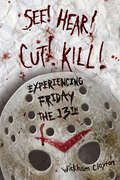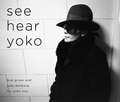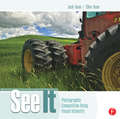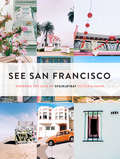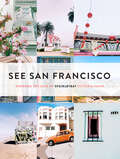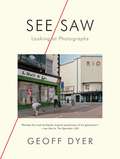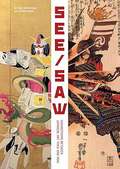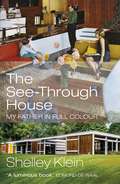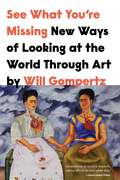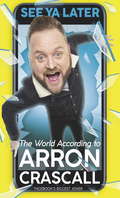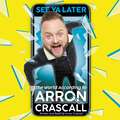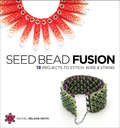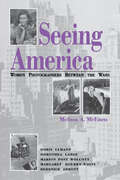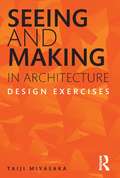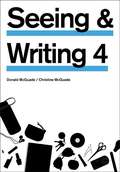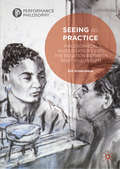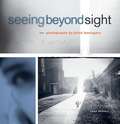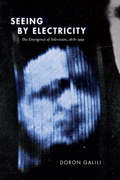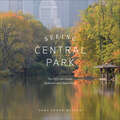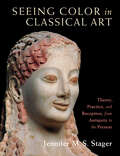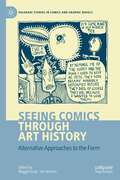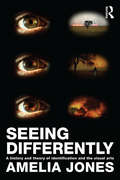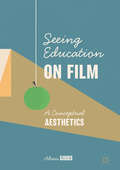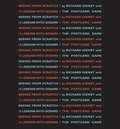- Table View
- List View
SEE! HEAR! CUT! KILL!: Experiencing Friday the 13th
by Wickham ClaytonSean S. Cunningham and Victor Miller’s Friday the 13th franchise is one of the most successful horror film franchises in history. To date, it includes twelve movies, a television show, comic books, and video games, among other media. In SEE! HEAR! CUT! KILL! Experiencing “Friday the 13th,” Wickham Clayton explores several aspects of the films including how the technical aspects relate to the audience, their influence on filmmaking, and the cultural impact of the franchise. Clayton looks at how perspective is established and communicated within the Friday the 13th films, which is central to the way the audience experiences and responds emotionally to these movies. Then he considers how each sequel gives viewers, whether longtime fans or new audiences, a “way in” to the continuous story that runs through the series. Clayton also argues that the series has not developed in isolation. These films relate to contemporary slasher films, the modern horror genre, and critically successful Hollywood films in general. They reflect popular trends of film style and often act as key examples in the genre and beyond.
See Hear Yoko
by Bob Gruen Jody DenbergConceived expressly for Yoko Ono as a gift between friends on the occasion of her eightieth birthday, See Hear Yoko is a visual portrait of an icon of contemporary American cultural history, from her days with John Lennon through to the present. Legendary rock and roll photographer Bob Gruen was welcomed into the lives of John Lennon and Yoko Ono during their years in New York City, when Gruen served as their personal lensman, and he continues to document Yoko today. Approached by his friend Jody Denberg, an Austin rock radio mainstay who had logged twenty-five years of interviews with Yoko, Gruen collaborated with him to create an extraordinary birthday gift. In this breathtaking volume, Gruen has selected more than three hundred classic color and black-and-white photographs--accompanied by text of Yoko's insights gleaned from Denberg's many hours of interviews--to illuminate the intimate story of Yoko Ono at the height of her fame as a woman, wife, mother, and avant-garde artist who keeps creating because, as she notes, "that's who I am." Yoko's role as a peace activist and artist underscores the enduring legacy of the era. See Hear Yoko reveals a modern woman in love, in ascension, in grief, in joy, and in peace.Lavish and beautiful, mirroring the deeply personal design of the original volume given to Yoko herself, See Hear Yoko brings into focus an extraordinary woman, and one of the most memorable periods in modern history.
See It: Photographic Composition Using Visual Intensity
by Josh Anon Ellen AnonA good image is more than just acceptable exposure and sharp focus -- two components that photography instruction concentrates on. A fascinating subject doesn't necessarily result in a good image, and likewise, it's possible to create an outstanding image of a mundane subject. So how do you know the difference? Perhaps you've read a lot of material on how to use your camera, how to manage images, and/or how to make adjustments using different software programs. What usually is not covered is what needs to be done beyond obvious exposure, noise, and sharpening issues so that you can intuitively recognize the difference between a good and bad image, and most importantly, why. That's where this book comes in. Rather than wasting time blindly trying one approach or another until something seems right, the quality of your imagery and the speed of your workflow will both vastly improve once you are able to articulate why you prefer one image to another. Expert authors Josh and Ellen Anon have spent years perfecting their visual-intensity based approach to composition, and in this gorgeous, full color guide, they'll share their techniques with you so that your overall photographic experience, both in terms of time investment and quality of output, will become a much more satisfying one.
See San Francisco: Through the Lens of SFGirlbyBay
by Victoria SmithFrom internationally popular design blogger SF Girl By Bay comes the ultimate love letter to San Francisco. This gorgeously photographed lifestyle guide gives readers an insider's tour of the City by the Bay through Victoria Smith's unique lens. Organized by neighborhood, each chapter features enchanting photos of hidden corners, local color, landmarks, and hotspots, revealing why so many people—Victoria included—are falling head over heels for this amazing city. Brimming with original, dreamy photography and packaged as a gorgeous jacketed hardcover, this lovely book makes a perfect gift for photography fans, San Francisco dwellers, visitors to the city, or anyone who has left their heart in San Francisco.
See San Francisco: Through the Lens of SFGirlbyBay
by Victoria SmithFrom internationally popular design blogger SF Girl By Bay comes the ultimate love letter to San Francisco. This gorgeously photographed lifestyle guide gives readers an insider's tour of the City by the Bay through Victoria Smith's unique lens. Organized by neighborhood, each chapter features enchanting photos of hidden corners, local color, landmarks, and hotspots, revealing why so many people--Victoria included--are falling head over heels for this amazing city. Brimming with original, dreamy photography and packaged as a gorgeous jacketed hardcover, this lovely book makes a perfect gift for photography fans, San Francisco dwellers, visitors to the city, or anyone who has left their heart in San Francisco.
See/Saw: Looking at Photographs
by Geoff DyerA lavishly illustrated history of photography in essays by the author of Otherwise Known as the Human ConditionSee/Saw shows how photographs frame and change our perspective on the world. Taking in photographers from early in the last century to the present day—including artists such as Eugène Atget, Vivian Maier, Roy DeCarava, and Alex Webb—the celebrated writer Geoff Dyer offers a series of moving, witty, prescient, surprising, and intimate encounters with images.Dyer has been writing about photography for thirty years, and this tour de force of visual scrutiny and stylistic flair gathers his lively, engaged criticism over the course of a decade. A rich addition to Dyer’s The Ongoing Moment, and heir to Roland Barthes’s Camera Lucida, Susan Sontag’s On Photography, and John Berger’s Understanding a Photograph, See/Saw shows how a photograph can simultaneously record and invent the world, revealing a brilliant seer at work. It is a paean to art and art writing by one of the liveliest critics of our day.
See/saw: Connections Between Japanese Art Then And Now
by Ivan Vartanian Kyoko WadaSee/Saw offers a provocative new look at the origins of Japanese pop art. Often defined by its references to manga or anime, contemporary Japanese art in fact has much broader roots. By drawing parallels between the art of Japan past and present, this compelling volume reveals how current artists rework the traditional forms and techniques of Japanese art history. Modern takes on time-honored conventions are illustrated by the work of a star-studded roster of contemporary artists including Tabaimo, Makoto Aida, Takashi Murakami, Yoshitomo Nara, and Yayoi Kusama. Aficionados of both contemporary and traditional Japan are sure to appreciate this fresh perspective on art and the power of visual culture.
The See-Through House: My Father in Full Colour
by Shelley Klein'A charming account of a daughter, a house and a fastidious dad' Sunday TimesShelley Klein grew up in the Scottish Borders, in a house designed on a modernist open-plan grid. With colourful glass panels set against a forest of trees, it was like living in a work of art. Her father, Bernat Klein, was a textile designer whose pioneering colours and textures were a major contribution to 1960s and 70s style.Thirty years on, Shelley moves back home to care for her father, now in his eighties: the house has not changed and neither has his uncompromising vision - or his distinctive way of looking at the world. Told with great tenderness and humour, this is Shelley's account of looking after an adored yet maddening parent and a piercing portrait of the grief that followed his death. 'A sad, funny, utterly fascinating book about families, home and how to say goodbye' Mark Haddon'Original, moving and bracingly honest... often hilarious' Blake Morrison, Guardian'It is strange that grief should produce such a life-affirming book, but it has. Read it for the solace it contains, or for its captivating descriptions. Either way, it's a delight' Telegraph
See What You're Missing: New Ways of Looking at the World Through Art
by Will GompertzTaking us into the minds of artists—from contemporary stars to old masters—See What You&’re Missing shows us how to look and experience the world with their heightened awareness.Artists are expert lookers: they have learned to pay attention. The rest of us spend most of our time on auto-pilot, rushing from place to place, our overfamiliarity blinding us to the marvellous, life-affirming phenomena of our world. But that doesn&’t have to be the case. In his inimitable engaging style, Will Gompertz takes us into the minds of artists—from contemporary stars to old masters, the well-known to the lesser-so, and from around the world—to show us how to look and experience the world with their heightened awareness. In See What You&’re Missing we learn, for example, how Hasegawa Tohaku can help us to see beauty, how David Hockney helps us to see colour, and how Frida Kahlo can help us see pain. In doing so we come to know the exhilarating feeling of being truly alive. See What You&’re Missing is at once entertaining and enlightening art history while delivering empowering new insights to its reader.
See Ya Later: The World According to Arron Crascall
by Arron CrascallAlright guys? It's me, Arron. Or as some people call me, 'that guy with the phone, the skinny jeans and the really fat head'.In a world that seems to be freefalling without a parachute towards utter chaos, I'm here to remind you that when life gives you lemons, make lemonade. No, in fact, when life gives you lemons, make a fool out of yourself in the lemonade aisle.*Because there's more to life than Brexit, Bake Off and banging on about being vegan. Yes, with this book - which is my take on the world - you will learn how to survive a proper lads' holiday, become a master in the art of takeaway ordering and find out about the pitfalls of seriously inappropriate tattoos.So do yourself a favour: turn off the news, cancel that juice cleanse, open your eyes to the brilliant, hilarious world we live in and most importantly . . . buy this book.SEE YA LATER! Arron x*Actually, don't do exactly that, that's my thing.
See Ya Later: The World According to Arron Crascall
by Arron CrascallArron Crascall is one of the UK's leading social media stars. Millions watch his videos online and he's guaranteed to bring a little bit of hilarity into your day.This book is his take on the world. The things that are important to Arron. The good, the bad and the stupid (there's a lot of this third one). You'll find stories about his past, a lot of views on the present and some opinions on how to make the future a more enjoyable place. It's part biography, part self-help book, part text book, part travel book (well, Dover at least), you'll find comedy, crime, drama, romance, and you'll even learn a thing or two about astro-physics (he's not even joking). In fact, he's putting so much into this book, you won't just see it in every bookshop in the country, you'll see it on every shelf in every bookshop in the country.Welcome to the world according to Arron Crascall. SEE YA LATER!
See Ya Later: The World According to Arron Crascall
by Arron CrascallAlright guys? It's me, Arron. Or as some people call me, 'that guy with the phone, the skinny jeans and the really fat head'.In a world that seems to be freefalling without a parachute towards utter chaos, I'm here to remind you that when life gives you lemons, make lemonade. No, in fact, when life gives you lemons, make a fool out of yourself in the lemonade aisle.*Because there's more to life than Brexit, Bake Off and banging on about being vegan. Yes, with this book - which is my take on the world - you will learn how to survive a proper lads' holiday, become a master in the art of takeaway ordering and find out about the pitfalls of seriously inappropriate tattoos.So do yourself a favour: turn off the news, cancel that juice cleanse, open your eyes to the brilliant, hilarious world we live in and most importantly . . . buy this book.SEE YA LATER! Arron x*Actually, don't do exactly that, that's my thing.Written and Read by Arron Crascall(p) Orion Publishing Group 2017
Seed Bead Fusion: 18 Projects to Stitch, Wire, and String
by Rachel Nelson-SmithThis fresh design approach to seed-bead jewelry will teach you how to fuse, merge, and mix materials and techniques, colors, inspiration, and design ideas for seed-bead jewelry with a contemporary edge.Seed Bead Fusion is all about:Fusing materials, techniques, and inspiration that creates eye-catching seed-bead jewelry.Mixing silver and copper wire, seed beads, Czech glass, and crystals for a unique melange of materials.Combining wirework with seed beads, beadweaving with wire, stringing with beadweaving, and multiple beadweaving stitches in a single piece to create extraordinary sculptural seed-bead jewelry.Finding design inspiration from a wide range of sources, including Indian Punjabi folk costumes and Native American beading.Detailed step-by-step photography adds a workshop aspect to the book.All of the basic beadweaving stitches, basic wirework, and stringing techniques are shown as illustrations in a getting-started section. The 18 projects are an inspired mixing of techniques in a single piece.
Seeing America: Women Photographers Between the Wars
by Melissa A. McEuenSeeing America explores the camera work of five women who directed their visions toward influencing social policy and cultural theory. Taken together, they visually articulated the essential ideas occupying the American consciousness in the years between
Seeing and Making in Architecture: Design Exercises
by Taiji MiyasakaYou always aim to achieve that moment of insight that leads to ingenuity and novelty in your design, but sometimes it remains elusive. This book presents a variety of techniques for mapping and making hands-on design/build projects, and relates this work to real architecture. It helps you to learn new ways of seeing and making that will enhance your creative design process and enable you to experience moments that lead to ingenuity in design. Each of the book’s two parts, "Seeing" and "Making," is organized according to technique, which ranges from quantitative analysis and abstraction to pattern and scale, to provide you with a framework for mapping and hands-on exercises. Interviews with architects Yoshiharu Tsukamoto (Atelier Bow-Wow) and Jesse Reiser and Nanako Umemoto (Reiser + Umemoto) give you perspective on using these exercises in practice.
Seeing and Writing (4th edition)
by Donald Mcquade Christine McquadeSeeing & Writing 4, with a new look, new features, and new essays and images, continues to lead the way as a visual, flexible, and above all, inspiring tool for the composition classroom.
Seeing as Practice: Philosophical Investigations into the Relation Between Sight and Insight (Performance Philosophy)
by Eva SchuermannThis study provides an overview of philosophical questions relating to sight and vision. It discusses the intertwinement of seeing and ways of seeing against the background of an entirely different theoretical framework.Seeing is both a proven means of acquiring information and a personality-specific way of disclosing the apparent, perceptible world, conditioned by individual and cultural variations. In a peculiar way, the eye holds a middle position between inside and outside of the self and its relations towards itself and others. This book provides a way out of false alternatives by offering a third way with reference to concrete cases of aesthetical and ethical experiences. It will be of particular interest to scholars of the phenomenology and philosophy of perception and it will be valuable to students of philosophy, cultural studies and art.
Seeing Beyond Sight: Photographs by Blind Teenagers
by Tony DeifellFor five years Tony Deifell taught teenagers to take photographs. His students were blind. Unusual as the idea may seem at first, putting cameras in the hands of visually impaired children proved to be extremely fruitful both for the photographers, who found an astonishing new means of self-expression, and for the viewers of their images, for whom this is an entirely new kind of dreamlike and intuitive creation. Even before you know that these pictures were taken by blind teenagers, they are striking in their use of light and composition, and haunting in their chiaroscuro intensity. To learn more, visit http://www.seeingbeyondsight.org/
Seeing by Electricity: The Emergence of Television, 1878-1939 (Sign, Storage, Transmission)
by Doron GaliliAlready in the late nineteenth century, electricians, physicists, and telegraph technicians dreamed of inventing televisual communication apparatuses that would “see” by electricity as a means of extending human perception. In Seeing by Electricity Doron Galili traces the early history of television, from fantastical image transmission devices initially imagined in the 1870s such as the Telectroscope, the Phantoscope, and the Distant Seer to the emergence of broadcast television in the 1930s. Galili examines how televisual technologies were understood in relation to film at different cultural moments—whether as a perfection of cinema, a threat to the Hollywood industry, or an alternative medium for avant-garde experimentation. Highlighting points of overlap and divergence in the histories of television and cinema, Galili demonstrates that the intermedial relationship between the two media did not start with their economic and institutional rivalry of the late 1940s but rather goes back to their very origins. In so doing, he brings film studies and television studies together in ways that advance contemporary debates in media theory.
Seeing Central Park: The Official Guide
by Sara Cedar MillerAn authoritative visual survey of New York City’s Central Park, with new photography and updated text.For more than 160 years, Central Park has been the centerpiece of New York City, with more than forty-two million visits each year. In Seeing Central Park, Sara Cedar Miller takes readers through America’s most popular and celebrated park, where natural and manmade features are interwoven into a spectacular work of art. Combining superb research and writing with breathtaking photographs, Seeing Central Park is not only a guide through every significant design feature but also a gorgeous gift book.Since the book was first published in 2009, the Conservancy has completed a number of renovations and opened new areas of the park, including the Hallett Nature Sanctuary, Rhododendron Mile, and Dene Slope. This updated edition features these landmarks alongside revised entries and new photography throughout. With its pastoral and picturesque landscapes, roads and paths, bridges, buildings, structures, and sculpture, Central Park is a living museum of superb Victorian decorative arts and landscape design. From the Pond to Harlem Meer, it’s all covered in Seeing Central Park.
Seeing Color in Classical Art: Theory, Practice, and Reception, from Antiquity to the Present
by Jennifer M. StagerThe remains of ancient Mediterranean art and architecture that have survived over the centuries present the modern viewer with images of white, the color of the stone often used for sculpture. Antiquarian debates and recent scholarship, however, have challenged this aspect of ancient sculpture. There is now a consensus that sculpture produced in the ancient Mediterranean world, as well as art objects in other media, were, in fact, polychromatic. Color has consequently become one of the most important issues in the study of classical art. Jennifer Stager's landmark book makes a vital contribution to this discussion. Analyzing the dyes, pigments, stones, earth, and metals found in ancient art works, along with the language that writers in antiquity used to describe color, she examines the traces of color in a variety of media. Stager also discusses the significance of a reception history that has emphasized whiteness, revealing how ancient artistic practice and ancient philosophies of color significantly influenced one another.
Seeing Comics through Art History: Alternative Approaches to the Form (Palgrave Studies in Comics and Graphic Novels)
by Maggie Gray Ian HortonThis book explores what the methodologies of Art History might offer Comics Studies, in terms of addressing overlooked aspects of aesthetics, form, materiality, perception and visual style. As well as considering what Art History proposes of comic scholarship, including the questioning of some of its deep-rooted categories and procedures, it also appraises what comics and Comics Studies afford and ask of Art History. This book draws together the work of international scholars applying art-historical methodologies to the study of a range of comic strips, books, cartoons, graphic novels and manga, who, as well as being researchers, are also educators, artists, designers, curators, producers, librarians, editors, and writers, with some undertaking practice-based research. Many are trained art historians, but others come from, have migrated into, or straddle other disciplines, such as Comparative Literature, American Literature, Cultural Studies, Visual Studies, and a range of subjects within Art & Design practice.
Seeing Differently: A History and Theory of Identification and the Visual Arts
by Amelia JonesSeeing Differently offers a history and theory of ideas about identity in relation to visual arts discourses and practices in Euro-American culture, from early modern beliefs that art is an expression of an individual, the painted image a "world picture" expressing a comprehensive and coherent point of view, to the rise of identity politics after WWII in the art world and beyond. The book is both a history of these ideas (for example, tracing the dominance of a binary model of self and other from Hegel through classic 1970s identity politics) and a political response to the common claim in art and popular political discourse that we are "beyond" or "post-" identity. In challenging this latter claim, Seeing Differently critically examines how and why we "identify" works of art with an expressive subjectivity, noting the impossibility of claiming we are "post-identity" given the persistence of beliefs in art discourse and broader visual culture about who the subject "is," and offers a new theory of how to think this kind of identification in a more thoughtful and self-reflexive way. Ultimately, Seeing Differently offers a mode of thinking identification as a "queer feminist durational" process that can never be fully resolved but must be accounted for in thinking about art and visual culture. Queer feminist durationality is a mode of relational interpretation that affects both "art" and "interpreter," potentially making us more aware of how we evaluate and give value to art and other kinds of visual culture.
Seeing Education on Film: A Conceptual Aesthetics
by Alexis GibbsThis book argues that certain films have more to offer by way of conceptualising education than textual scholarship. Drawing on the work of the later Wittgenstein, it suggests that a shift in our philosophical focus from knowing to seeing can allow for ordinary educational phenomena (teachers, schools, children) to be appreciated anew. The book argues that cinema is the medium best placed to draw attention to this revaluation of the everyday, and particular films are presented as offering unique insights into the aesthetic nature of education as a concept. The book will be of primary interest to educators and educationalists alike, but its interdisciplinary nature should also appeal to those in the fields of film study, philosophy, and aesthetics.
Seeing from Scratch: Fifteen Lessons with Godard
by Richard DienstTaking as his starting point fifteen characteristically penetrating epigrams by Jean-Luc Godard, Richard Dienst invites us to trace a new path through some of the fundamental questions of cinema. Godard has never stopped offering lessons about seeing and thinking, always insisting that we have to learn how to start over. By starting over "from scratch," Godard challenges us to rethink our ideas about embodied perception, material form and the politics of making images. Less a commentary on Godard's oeuvre than an outline of a Godardian pedagogy, Seeing from Scratch offers a theoretical exercise book for students, teachers and practitioners alike, pursuing unexpectedly far-reaching ways to think through images. Along the way we encounter, in this brief, accessible essay, ideal for classroom use, a wide range of thinkers whose ideas are put to use working through the intellectual and aesthetic questions and challenges Godard's epigrams suggest – not in the abstract, but as part of the book's practical approach to intellectual problem solving. In its conversational tone, return to fundaments and practical pedagogical approach, Seeing from Scratch is an essay for the media age in the mould of John Berger's Ways of Seeing from the 1970s: a new way of discussing the theory and practice of images and the film image. A companion piece, "The Postcard Game," presents a scene from an imaginary classroom, where a stack of postcards – like those found throughout Godard's work – provokes a spiralling series of questions about images, texts and the manifold pathways of the creative process.
